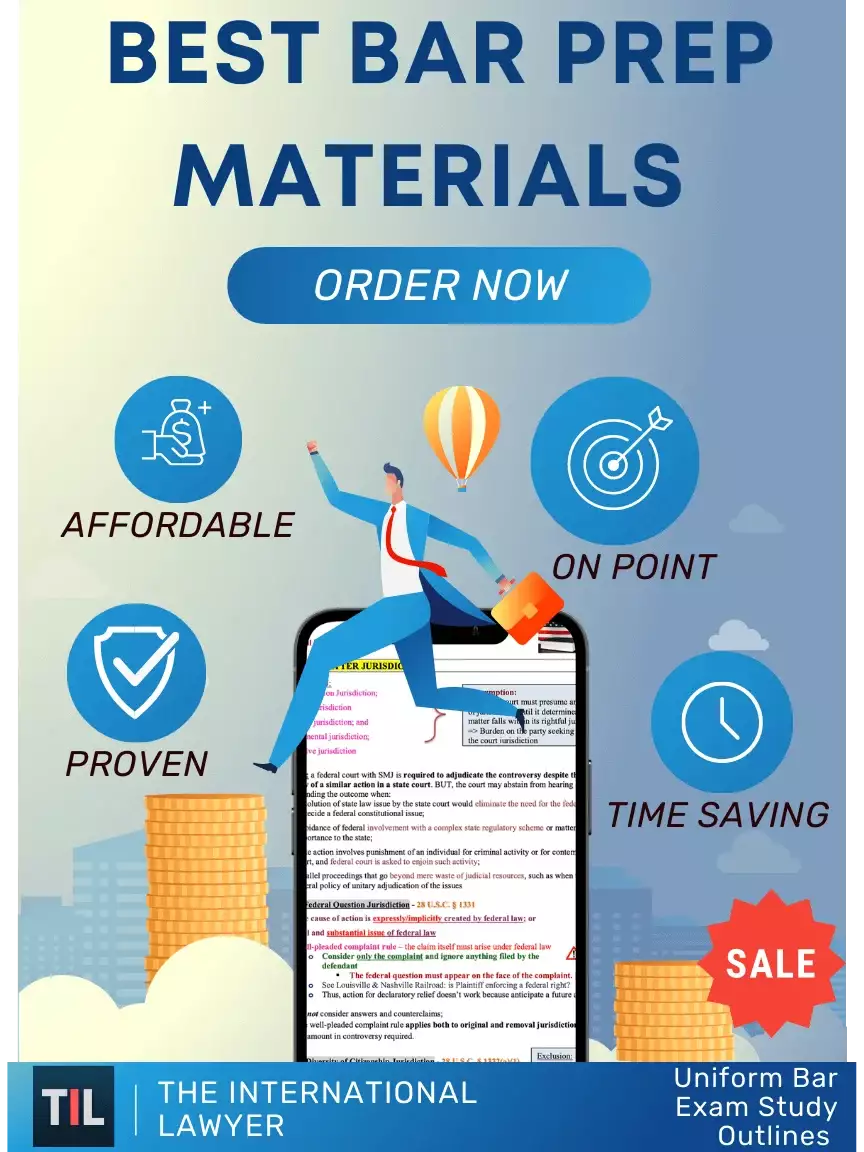The NY Bar Exam, a guide for LL.M students
Structure and layout of the Bar Exam

New York is a Uniform Bar Exam (UBE) jurisdiction, it basically means that it administers a uniform exam rather than a New York-specific bar examination. The Exam is administered twice a year, in July and in February, on the last Tuesday and Wednesday of those months.
The UBE consists of three components: the Multistate Bar Exam (“MBE”); the Multistate Essay Examination (“MEE”); and the Multistate Performance Test (“MPT”).
The three components are tested over two days. Below, you will find a description of each of those component but you can also visit the New York State Board of Law Examiners website for more information.
1. The Multistate Bar Exam ("MBE")

The Multistate Bar Exam, or “MBE,” is a multiple-choice test administered by the National Conference of Bar Examiners (NCBE).
It has 200 multiple-choice questions to be completed within six hours. The exam is divided into two 100-question sessions. A hundred in the morning, and another hundred in the afternoon.
Only 175 of the 200 multiple-choice questions are scored. 25 of the questions are “test” questions that are unscored.
A. Subjects tested on the MBE:
- Civil Procedure
- Constitutional Law
- Contracts and Sales
- Criminal Law and Procedure
- Evidence
- Real Property
- Torts
You will have 25 scored questions on each subject: this mean that the subjects are tested equally. (which is not the case of the Essay portion of the Bar Exam)
As indicated above, you will be scored on 175 questions in total: 25 questions on the test won’t be scored and can cover any subject.
The MBE tests only the majority law and federal rules. (as opposed to state law). In class, your teacher might only teach the law of your state.
B. Score needed on the MBE:
It all depends on your jurisdiction. In New York State, 133/200 is considered a passing score. However, most jurisdictions do not have a “minimum” MBE score (including New York).
In theory, you could compensate a lower score on the MBE with a higher score on the written portion for instance.
C. What is the MBE weight in the UBE:
The MBE portion of the Bar Exam is the most important and represent 50% of the UBE.
D. How do I prepare for the MBE:
There are many ways to prepare for this portion: memorize the law, practice answering as many questions as you can, have real-conditions exam, etc! The International Lawyer regularly provides tips and advice, so subscribe now to our website and don’t miss any of our posts.
We also have a whole set of resources for the MBE part, including detailed outlines. For more information, visit our store.
2. The Multistate Essay Exam ("MEE")

The Multistate Essay Exam, or “MEE”, is a six 30-minute questions test. Some questions may include issues in more than one area of law. For more information, consult the MEE instructions.
A. Subjects tested on the MEE:
- Business Associations (Agency and Partnership; Corporations and Limited Liability Companies);
- Civil Procedure;
- Conflict of Laws;
- Constitutional Law;
- Contracts (including Article 2 [Sales] of the Uniform Commercial Code);
- Criminal Law and Procedure;
- Evidence;
- Family Law;
- Real Property;
- Tort;
- Trusts and Estates (Decedents’ Estates; Trusts and Future Interests); and
- Article 9 (Secured Transactions) of the Uniform Commercial Code.
Only six topics will be covered on the bar exam: while you might play the game of predictions, we recommend you to prepare for each topics as any of them can be on the exam.
B. Format of the MEE:
With only 30 minutes per essay, you have to master the methodology of the essay and control your time. The International Lawyer will provide you with a complete method, but for now, here is how your essay should be written:
- Conclusion: start with your conclusion. Your examiner want you to go straight to the point.
- Issue: clear and concise issue. What is the problem of law here?
- Rule: the rule of law is important, but be synthetic. For example, list the elements to be met in order to comply with the rule of law.
- Application: this is where you show the examiner that you understand how the law is applied. Apply the facts your rule!
- Conclusion: end by re-writing the conclusion.
This is the “CIRAC” method, and while you might know other method (such as “IRAC”), this is the favorite format for examiners. When you start reading your Essay Question, think “CIRAC”.
C. Score needed on the MEE:
Only the overall score counts: you could miss one essay and make up the points with the five remaining essays. Basically, 4 essays over 6 will be considered a passing score.
But how is an essay graded? the correction guidelines state that your “answer must demonstrate that the applicant understands the facts fairly well, recognizes most of the issues and the applicable principles of law, and has the ability to reason to a conclusion in a satisfactorily written paper.”
D. Weight of the MEE overall:
The MEE portion represents 30% of the Bar Exam.
E. How to prepare for the MEE:
The secret is in spotting the issue. If you miss the issue, your whole essay might be irrelevant to the question. Read as many essays as you can, along with their correction. The more you practice, the better.
Be mindful of the format: train to write concisely. Everything is active voice, not passive voice. Write: The dog bit the man, not: the man was bitten by the dog.
We, at The International Lawyer , will regularly post about how to succeed on the Bar Exam, so subscribe now to our website and don’t miss any of our posts.
We also have a whole set of resources for the MBE part, including Essay Attack sheets, and Tutoring. For more information, visit our store.
3. The Multistate Performance Test ("MPT")

The Multistate Performance Test, or “MPT” consists of two 90-minute methodology exercises. It is designed to “test an examinee’s ability to use fundamental lawyering skills in a realistic situation and complete a task that a beginning lawyer should be able to accomplish.”
Basically, the MPT is not a test of substantive knowledge.Rather, it design to evaluate the necessary skills that lawyers are expected to demonstrate.
“Great, I don’t have to study for the MPT” – not so fast young student. While most examinees ignore the MPT, it is a great occasion to score points, and perhaps make up for other portions of the Bar Exam.
A. What's the matter with the MPT:
First, it seems easy: after all you don’t need to know the law because it will be provided to you. Secondly, your bar review courses won’t spend much time on it, so why should you? Finally, many of use think that they are good writers: after many years of law school, writing a memorandum should be a piece of cake.
Wrong. The MPT portion represents 20% of the UBE.It is too big to be ignored. If you don’t prepare for this portion, you might either encounter a task you have never met before (have you ever written a prenuptial agreement?); or you might simply run out of time on the actual exam.
Many students fail the Bar Exam due to the MPT portion of the exam. It is like achieving the highest level of the game and then running out of battery.
B. But what is an MPT?:
You basically have to pretend to be a first-year associate at a law firm: on the test, you will receive a new task from your employer giving you an assignment. It can be either writing memorandums, client letters, contacts or legal briefs.
Then, two sets of documents will be given to you: the File and the Library.
The File
The File is a collection of documents. The NCBE explains that the File might include “ transcripts of interviews, depositions, hearings or trials, pleadings, correspondence, client documents, contracts, newspaper articles, medical records, police reports, or lawyer’s notes.”
But not every information is relevant: the File might intentionally contains relevant and irrelevant information. It’s part of the “real life game”.
So you will basically have to go through the File to get the substance necessary to answer the question being asked.
The Library
The Library is your toolbox. Again, the NCBE says that the Library may include “cases, statutes, regulations, or rules.”
You will have to extract your rules or elements of law from the Library to apply them to the problem at hands. And once again: your library might contain irrelevant information. This is because the examiner want to test how you understand the problem and how you treat it.
C. So, how to prepare for the MPT ?:
While we recommend not to spend quantity of time on this portion, do not neglect it. The MPT is largely an exercise in critical thought and analysis. Similarly to the MEE, you could read MPT and their answer to understand the methodology.
And with a little practice writing MPTs of your own, this section could be crucial for making up points lost in other sections.
The International Lawyer is a website, made by LL.Ms, by LM.Ms. In a very complex environment, and under limited time, we understand that it is difficult to cover everything and to understand all the information.
For this reason, we have a whole set of resources for the Bar Exam, including Outlines, Essay Attack sheets, and Tutoring. For more information, visit our store and our special page on the NY Bar Exam.





[…] General Information […]